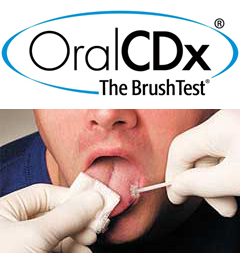Oral Cancer Exams and Biopsies
Every visit to our office includes an oral cancer screening exam. However, you are the most important person in an early diagnosis. You should look for any sores or lesions in your mouth that do not heal within two weeks. If you notice these, contact us for an appointment as soon as possible.
Symptoms to Watch For:
- A lump or thickening in the cheek
- A white or red patch on the gums, tongue, tonsils, or lining of the mouth
- A sore throat or a feeling that something is caught in the throat
- Difficulty chewing or swallowing
- Difficulty moving the jaw or tongue
- Numbness of the tongue or other area of the mouth
- Swelling of the jaw that causes dentures to fit poorly or become uncomfortable
These symptoms may be caused by other, less serious problems, but they also indicate the possible presence of oral cancer. After the physical examination of your mouth, if we find any areas that are suspicious, we may recommend a biopsy. In this procedure, we simply take a small portion of the suspicious tissue and send it to an oral pathologist for examination under a microscope.
Types of Biopsies
Incisional
The most traditional type of biopsy is incisional. In an incisional biopsy, we remove part of or the entire lesion, depending upon its size and extent. The sample of tissue is then sent to a pathologist who examines the tissue under a microscope to check for abnormal or malignant cells.
Fine Needle Biopsy
When dealing with an area of significant mass, such as an enlarged lymph node, fine needle aspiration cytology (fine needle biopsy or FNB) is reliable and relatively inexpensive. A small needle attached to a syringe is inserted into the questionable mass, and cells are aspirated, or pulled out into the syringe.
Punch Biopsy
In this case, a very small circular blade is pressed down into the suspicious area to cut a round border, allowing us to remove a perfect plug of cells from the sampled area. The area where the plug was removed is small, will not bleed much, and heals normally without the need for stitches.
OralCDx
 A new way to test for oral cancer is a system called OralCDx. Using a special, hand-held brush, we take a small sample of tissue from the suspicious lesion. The sample is put on a slide and sent to the CDx Laboratories. At the lab, computers use advanced robotics and scanning and imaging techniques to accurately examine the thousands of cells on the sample. The computer is able to look at every cell, compare them to libraries of normal and abnormal cells, and determine which cells are potentially problematic. A summary report is returned to us for our files or for further discussion with you. If the OralCDx test is positive or atypical, we will then confirm it with a standard incisional biopsy. If the OralCDx test turns out to be negative, but the lesion persists, will will schedule a follow-up evaluation.
A new way to test for oral cancer is a system called OralCDx. Using a special, hand-held brush, we take a small sample of tissue from the suspicious lesion. The sample is put on a slide and sent to the CDx Laboratories. At the lab, computers use advanced robotics and scanning and imaging techniques to accurately examine the thousands of cells on the sample. The computer is able to look at every cell, compare them to libraries of normal and abnormal cells, and determine which cells are potentially problematic. A summary report is returned to us for our files or for further discussion with you. If the OralCDx test is positive or atypical, we will then confirm it with a standard incisional biopsy. If the OralCDx test turns out to be negative, but the lesion persists, will will schedule a follow-up evaluation.


